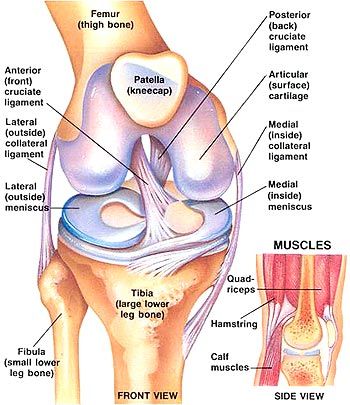Knee Ligament Injury: Sports Chiropractor Discusses Anatomy, Symptoms & Treatment Strategies. Question? Speak To A Therapist. Call (24/7): 1300-003-777
Ligaments are responsible for providing structural stability and strength to your joints. If joints are stretched beyond there normal range of motion this leads to stress upon ligaments and therefore the development of ligament injury. Ligaments are bundles of collagen connective tissue that originate at one aspect of a bone or joint and insert into another. Ligaments are deceptively strong and flexible making them a very important structure within the human body. Leading Sports Chiropractor, James Allen discusses knee ligament injury as it’s a common clinical presentation within musculoskeletal clinics.
Anatomy Of The Knee Joint
The knee is the largest joint in the body and unfortunately one of the most easily injured. The knee joint consists of bone, cartilage, ligament and tendons:
- Bones: Three bones form an articulation to create the knee joint including the femur, tibia and patella.
- Articular cartilage: At the end of both the femur and tibia as well as the posterior aspect of the patella there is a thin material called articular cartilage. This substances allows your knee to glide smoothly during movement.
- Meniscus: There is a medial and lateral meniscus which act as shock absorbers to distribute stress which is placed upon the knee during activity.
- Medial and Lateral Collateral Ligaments: Found on both the inside and outside of the knee joint to control unnecessary sideways motion.
- Anterior and Posterior Cruciate ligaments: Situated within the knee joint and form a cross like structure to effectively position the knee from unnecessary forward and backward motion of the knee. Common causes of knee ligament injury during sports related activity.
- Tendons: Provide an attachment of muscle to bone.
Sprained Knee Signs & Symptoms
The severity of your symptoms depends upon the level of knee ligament injury.
- Grade 1: Overstretching of the ligament is noted however the ligament fibres remain intact.
- Grade 2: Partial ligament fibre tearing is noted, pain is moderately more intense then a Grade 1 injury.
- Grade 3: Complete tear of ligament is noted, significant pain, unstable joint laxity is typically noted upon examination.
Typical signs and symptoms of knee ligament injury include:
- Often sudden onset of pain during activity.
- A “pop” or snapping type sound may be heard.
- Knee joint swelling following injury is sustained.
- Joint laxity or abnormal knee movement may be noted.
- Inability to appropriately weight bear or walk.
How Are Ligament Injuries Treated?
Conservative management is fantastic for assisting individuals recover from knee ligament injury. Treatment that may be provided by your allied health practitioner includes:
- Strategies to assist with reducing swelling such as heat/ice advice and ultrasound therapy.
- Mobilisation of the knee joint to ensure proper movement and joint alignment.
- Exercises designed to restore muscular strength, proprioception, agility and power.
Chiropractor Knee Ligament Injury Research
- There is little doubt that pre‐operative conservative rehabilitation strategies has a significant positive effect on motor function in individuals suffering from anterior cruciate ligament injury and should therefore be routinely recommended to maximize muscle stabilization prior to surgical intervention. Keays, S. (2006). The effectiveness of a pre-operative home based Physiotherapy programme for chronic anterior cruciate ligament deficiency. Physiotherapy Research International, 11(4); 204 – 218
- Quadriceps strength, functional knee score, activity level and functional performance all demonstrated clinically significant improvements following intervention. Friden, T. (1991). Anterior cruciate insufficient knees treatment with Physiotherapy. A three year follow up study of patient with late diagnosis. Clinical Orthopaedics & Related Research, 263; 190 – 199
Additional Information
If you wish to continue your reading about Knee Ligament injury please click here.

